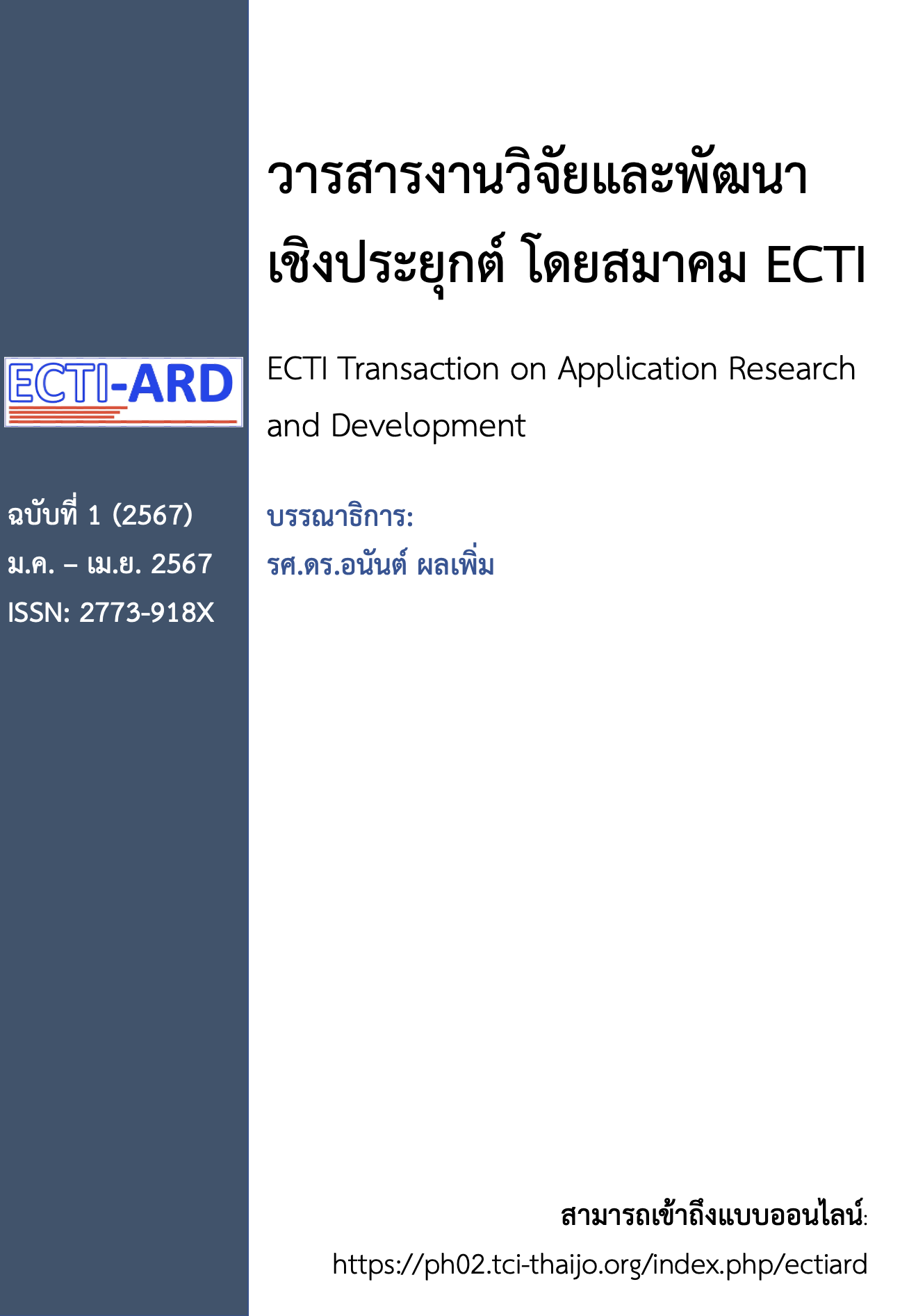การเปรียบเทียบประสิทธิภาพของโครงข่ายประสาทเทียมแบบคอนโวลูชัน เพื่อจำแนกอักขระขอมไทยในคัมภีร์โบราณทางพระพุทธศาสนา
Main Article Content
บทคัดย่อ
คัมภีร์สำคัญทางพระพุทธศาสนาในประเทศไทย เช่น พระไตรปิฎก มีจำนวนมาก ถูกบันทึกอยู่ในแผ่นกระดาษหรือใบลานด้วยอักขระขอมไทย และเสี่ยงต่อความเสียหายในอนาคต การถอดความจากเอกสารสำคัญทางพระพุทธศาสนามีความสำคัญต่อการศึกษาหลักฐานทางประวัติศาสตร์ของศาสนาพุทธในไทย แต่ยังคงใช้ผู้เชี่ยวชาญในการอ่านและถอดความอักขระขอมไทยเป็นอักขระไทย งานศึกษานี้มีวัตถุประสงค์เพื่อพัฒนาและเปรียบเทียบโมเดลจากการเรียนรู้เชิงลึกโดยโครงข่ายประสาทเทียมแบบคอนโวลูชัน (Convolutional Neural Network - CNN) สำหรับการรู้จำอักขระขอมไทย โครงสร้างที่ใช้ในการเรียนรู้ประกอบด้วย CNN ที่แตกต่างกัน 10 โครงสร้าง, ResNet50 และ ResNet50V2 โดยเก็บรวบรวมชุดข้อมูลจากภาพลายมือเขียนจากคัมภีร์พระธัมมกายาทิ และภาพลายมือเขียนในตำราเรียนอักษรขอมไทย จำแนกเป็นอักขระขอมไทย 96 รูปแบบ แบ่งชุดข้อมูลออกเป็น 3 ชุด คือ ข้อมูลชุดฝึก ข้อมูลชุดตรวจสอบ และข้อมูลชุดทดสอบ โดยกำหนดรอบในการฝึกที่ 10 รอบ จากการศึกษาพบว่าโมเดลโครงสร้าง 1 ใน 10 โครงสร้างที่สร้างขึ้น มีค่าความถูกต้องมากที่สุด คือ 79.25% ใช้เวลาในการฝึก 250.72 วินาที เมื่อเทียบกับโมเดลที่ใช้โครงสร้าง ResNet50 ที่มีค่าความถูกต้อง เท่ากับ 77.88% และใช้เวลาในการฝึก 1,514.13 วินาที จึงสรุปได้ว่า โครงสร้าง CNN ที่สร้างขึ้นสามารถนำไปพัฒนาต่อเป็นโมเดลสำหรับการรู้จำอักขระขอมไทย
Article Details

อนุญาตภายใต้เงื่อนไข Creative Commons Attribution-NonCommercial-NoDerivatives 4.0 International License.
เอกสารอ้างอิง
M. Lohakan, S. Airphaiboon, and M. Sangworasil. “Single-character segmentation for handprinted Thai word”. International Conference on Document Analysis and Recognition. 20-22 Sep. Bangalore India : pp. 661–664, 1999. doi: 10.1109/ICDAR.1999.791874.
C. Yingsaeree and A. Kawtrakul. “Rule-based middle-level character detection for simplifying Thai document layout analysis”. International Conference on Document Analysis and Recognition. 29 Aug-1 Sep. Seoul South Korea : pp. 888-892, 2005. doi: 10.1109/ICDAR.2005.204.
C. K. Nguyen, C. T. Nguyen, and N. Masaki. “Tens of Thousands of Nom Character Recognition by Deep Convolution Neural Networks”. International Workshop on Historical Document Imaging and Processing. 10-11 Nov. Kyoto Japan : pp. 37–41, 2017. doi: 10.1145/3151509.3151517.
K. S. Younis and A. A. Alkhatee., “A New Implementation of Deep Neural Networks for Optical Character Recognition and Face Recognition”. New Trends in Information Technology. 25-27 Apr. Amman Jordan : 2017.
A. Singh, S. Jangra, and G. Aggarwal. “EnvisionText: Enhancing Text Recognition Accuracy through OCR Extraction and NLP-based Correction”. International Conference on Cloud Computing, Data Science & Engineering. 18-19 Jan. Uttar Pradesh India : pp. 47–52, 2024. doi: 10.1109/Confluence60223.2024.10463478.
K. B and H. M. “Offline Handwritten Basic Telugu Optical Character Recognition (OCR) using Convolution Neural Networks (CNN)”. International Conference on Computing for Sustainable Global Development. 15-17 Mar. New Delhi India : pp. 1195–1200, 2023.
A. Kashyap and A. Kumara B. “OCR of Kannada Characters Using Deep Learning”. Trends in Electrical, Electronics, Computer Engineering Conference. 26-27 May. Bengaluru India : pp. 35–38, 2022. doi: 10.1109/TEECCON54414.2022.9854842.
S. K. Manocha and P. Tewari. “Comparative Study of Deep Learning Models for Devanagari OCR”. International Conference on Smart Generation Computing, Communication and Networking. 29-30 Oct. Pune India : pp. 1–7, 2021. doi: 10.1109/SMARTGENCON51891.2021.9645924.
A. Razdan, A. Raghavan, M. Panandikar, A. Pol, K. Hedaoo, and R. Patil. “Recognition of Handwritten Medical Prescription using CNN Bi-LSTM With Lexicon Search”. International Conference on Computing Communication and Networking Technologies. 6-8 Jul. New Delhi, India : pp. 1–6, 2023. doi: 10.1109/ICCCNT56998.2023.10307451.
N. M. Dipu, S. A. Shohan, and K. M. A. Salam. “Bangla Optical Character Recognition (OCR) Using Deep Learning Based Image Classification Algorithms”. International Conference on Computer and Information Technology. 18-20 Dec. Dhaka Bangladesh : pp. 1–5, 2021. doi: 10.1109/ICCIT54785.2021.9689864.
M. K. Gupta, S. Vikram, S. Dhawan, and A. Kumar. “Handwritten OCR for word in Indic Language using Deep Networks”. International Conference on Signal Processing and Integrated Networks. 23-24 Mar. Noida India : pp. 389–394, 2023. doi: 10.1109/SPIN57001.2023.10117106.
S. Patel, D. Sanghavi, and A. Nanade. “Modernizing Data Processing: CNNs and OCR for Automated Document Classification and Data Extraction”. Global Conference on Information Technologies and Communications. 1-3 Dec. Bengaluru India : pp. 1–8, 2023. doi: 10.1109/GCITC60406.2023.10426541.
T. T. Dao, C. T. Le, T. D. Ngo, and T. H. Le. “Detection and Recognition of Sino-Nom Characters on Woodblock-Printed Images”. in 2023 15th International Conference on Knowledge and Systems Engineering. 18-20 Oct. Ha Noi Vietnam : pp. 1–6, 2023. doi: 10.1109/KSE59128.2023.10299440.
P. S. M et al., “CNN Based Character Recognition and Classification in Tamil Palm Leaf Manuscripts”. International Conference on Communication, Computing and Internet of Things. 10-11 Mar. Chennai India : pp. 1–6, 2022. doi: 10.1109/IC3IOT53935.2022.9767866.
C.-C. Chang, A. Arora, L. P. Garcia Perera, D. Etter, D. Povey, and S. Khudanpur. “Optical Character Recognition with Chinese and Korean Character Decomposition”. International Conference on Document Analysis and Recognition Workshops. 22-25 Sep. Sydney Australia : pp. 134–139, 2019. doi: 10.1109/ICDARW.2019.40094.


